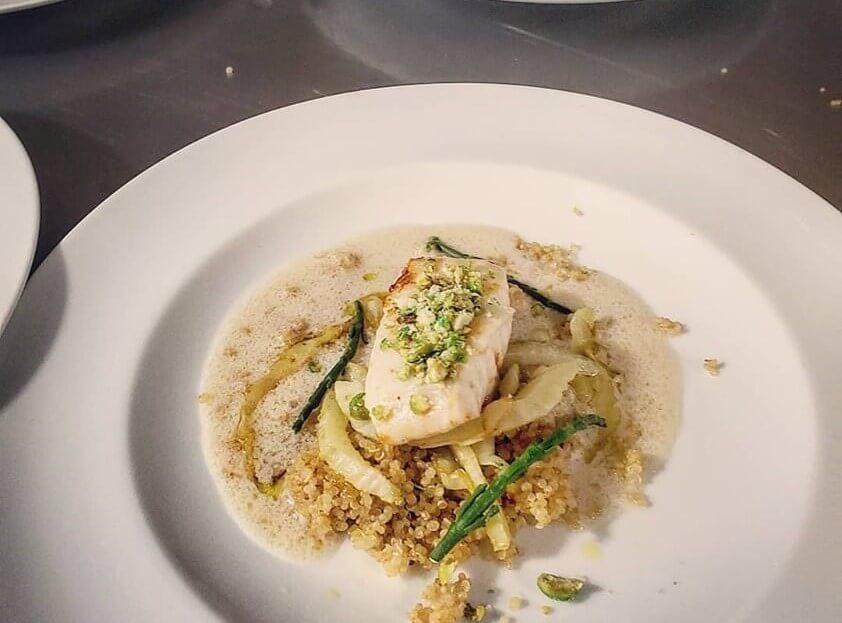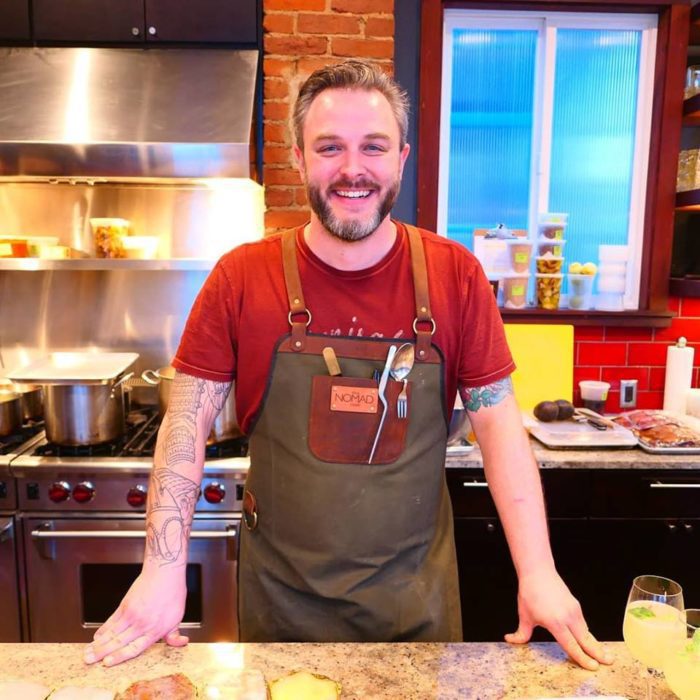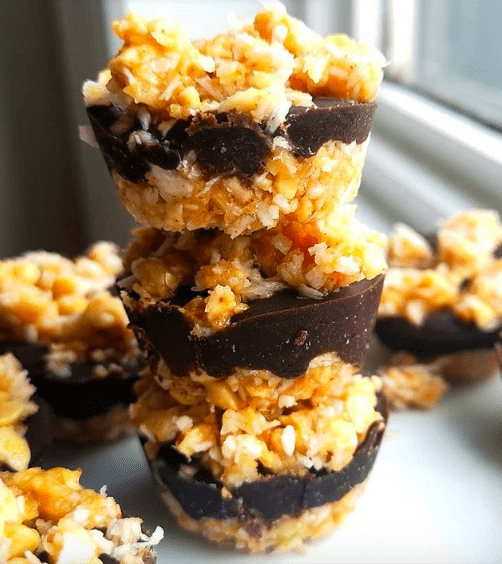A single ingredient can elevate a recipe to the next level. It can make or break a dish and keep people coming back for more. One single ingredient is putting Canada on the path to becoming a world-leading culinary destination. It is, after all, the first country where chefs are legally allowed to work with cannabis in the kitchen.
With the edibles market opening in October 2019, professional chefs and bakers alike are creating dishes that go above and beyond what has typically been consumed in the cannabis world. And while cookies, brownies, and gummies will forever have their place, the future is in fine dining and incorporating the goodness of the plant with wholesome foods. Think chicken THC noodle soup with CBD broth; roasted duck with a THC-infused cherry sauce; eggs benedict with canna-hollandaise; THC butter-poached salmon, and so much more.
“It’s not about coming to get stoned. Although, some people come to do that,” explains cannabis chef, Travis Petersen. “When micro-dosing cannabis properly, it opens up for a new dining experience. It opens your palate up; you become a little more friendly.”
Petersen is Canada’s leading weed-chef. After a brief stint on MasterChef Canada, he combined his passions for cannabis and cooking in a way that broke the ‘sweets’ mold. Also known as The Nomad Cook, Petersen travels from coast to coast and sometimes beyond hosting private cannabis dinners, where he has learned that the people interested in edibles range in age and come from various cultural and professional backgrounds.
“It just blew me away, watching the 20-year-olds and the 68-year-old trade party stories. There’s a 50-year age gap there, and it doesn’t matter.”
Never before has a chef had so much responsibility with a single ingredient, and Petersen treats his culinary creations with a tremendous amount of care. He strives to introduce his clients to the cannabis space in the safest way possible, infusing his dishes with distillate so he can microdose both THC and CBD, leading to what is known as the ‘entourage effect.’

“The important thing is to balance the THC with CBD,” he says. “Think of THC and CBD as two musical instruments. They both sound good on their own, but when we put a guitar and a bass together, all of a sudden, we’ve got a band. When they’re working together, both become stronger, and they compliment each other.”
A lemon has nine terpenes that make up its citrus smell and flavor; cannabis has more than one hundred. Petersen believes the future of cannabis edibles is in the terpenes and how they can be extracted for the desired effect on the consumer. For example, the chef says he would start a dinner party with an appetizer containing THC and the terpene myrcene, which typically gives people the munchies, making them hungry for the several courses ahead.
“That first course is infused with limonene, so now we’re going to give you some energy. All of a sudden, you’re a little more chatty than you’d normally be,” Petersen explains. “Then we move on and we use humulene; we want to suppress your appetite because we’re getting to the end of it. We want to finish off with linalool, which is found in lavender, to give you that nice calming, relaxing feeling heading out.”
Petersen and his fellow cannabis chefs are treading carefully in this new market; it is encircled with red tape and for a good reason. Working together, Peterson believes Canada can create industry standards of safety practices, procedures, and techniques that other countries will eventually follow.
“I don’t think someone in Italy is saying they want to get on a plane and go to Canada to eat food,” he says. “But they might with cannabis if we make this ours.”
Legalization: Phase Two
The Canadian edibles market opens on October 17, 2019, a date many are calling ‘Legalization 2.0.’ for its potential to revolutionize the cannabis industry. Health Canada has limited the amount of THC to 10 milligrams per package, driving home the message ‘start low, go slow’. In addition to various ready-to-eat products, beverages, topicals, and extracts will also hit store shelves just before Christmas, breaking down barriers along the way.
“People [consuming] edibles tend to be the newer user,” explains Joshua Tuck of the Cannabis Cooking Company. “A lot of people who want to explore cannabis don’t want to start smoking. They weren’t smoking previously, so what’s the best way to enter cannabis? That would be through edibles.”
Those products are expected to swell the ranks of cannabis consumers by 1.5 million Canadians come the fall. A survey of 3,000 people by Lift & Co.’s consumer, non-consumer, and budtender panels found the population can be divided into four distinct groups:
- The “Canna-Savy” category makes up 10% of Canada’s adult population and includes mostly males who spend an average of $250/month on cannabis products and consume daily.
- The “Canna-Casual” group makes up 7% of adults and is comprised of mostly older people looking for pain relief. They consume cannabis approximately once per week and spend an average of $100/month on products.
- The “Canna-Curious” category makes up 23% of Canadian adults and represents people who have not yet tried cannabis products but are interested in lightly experimenting with low-dose edibles and topicals.
- The “Unconvinced” represents 60% of adults and includes people who don’t support legalization and likely won’t be experimenting with cannabis anytime soon.
The research also shows that Canadians are most interested in the quality, effects, potency, and price of the products coming to the edible market. And yet, there is a lack of knowledge in the industry; people don’t know enough about the differences between THC and CBD, or about how edibles will affect our bodies. According to many industry experts who attended the Lift & Co Cannabis Expo in Toronto, Canada, last June, education is the biggest hurdle the industry currently faces.
“We want people to have a great experience with edibles and understand them, and we really believe that this was missed in the initial legalization of cannabis,” says Tuck. “Cannabis is legal right now but is it really accessible to everybody? Not really, because they don’t know what they want or need. So, we aim to educate people as best we can and help where we can help.”
Tuck and his partner Vanessa Labrecque started the Cannabis Cooking Company in July 2018 to teach consumers how to make edibles at home responsibly. Their cooking classes were an immediate success with participants of all ages and backgrounds, and they were struck by how little education there is where edibles are concerned. For years, people have been buying products from the black market, which usually come in very high doses and with little guidance or information.
“For the new users coming to the market, eating these 300-milligram cookies, you’re going to have a really bad experience, especially if you don’t know that you’re supposed to only eat a crumb of a cookie that strong,” explains Labrecque.
With portion control being a problem for so many of us, Labrecque set out to create healthy recipes that include cannabis in low, accurate, and evenly-dispersed doses so that we don’t have to hold back from having seconds. One of her favorite recipes is a healthy power bar that includes goji berries, cranberries, coconut, natural peanut butter, flax, hemp, and chia seeds, and cannabis, of course.
“In our classes, we did see the need for healthy alternatives,” she says. “We have a lot of vegan people, a lot of gluten-free people, a lot of people with dietary allergies these days, so we do bake power balls and have vegan classes, [which] are actually our most popular classes.”
Industry experts predict the health and wellness sector will be one of the most popular where cannabis edibles are concerned. In Canada, the Neal Brothers brand has been creating nutritious snacks for 31 years. Now, it’s teaming up with HEXO to infuse cannabis into the good quality foods it’s known for making. Peter Neal, the Co-founder of Neal Brothers, says they are reinventing the wheel with the concepts of non-GMO, organic, and fair-trade at the forefront.
“Beyond the chocolate and gummies, we’ve got some exciting stuff coming out, but that will come with a better understanding of extraction methods and different types of cultivars we can use to infuse,” he says.
Beverage Bonanza
There is perhaps no edibles category more exciting than beverages. Cannabis-infused cocktails and brews are being touted as a healthier and safer alternative to alcohol; by 2025, they’re expected to become the number one way cannabis will be consumed in Canada and will likely exceed $1.8 billion in annual sales.
“It’s a pain in the ass to step outside and smoke,” says Dooma Wendschuh, Co-founder and CEO of Province, a company specializing in psychoactive products. “It is challenging for a lot of people to learn how to use vaporizers […] Given the choice, people will prefer to consume psychoactive beverages. It’s just natural.”
Many companies are designing the beverages to be a viable replacement for alcohol, one that enters and leaves the body at the same rate. Someone who consumes the drinks should not still have cannabis in their systems two days later.
“We are going to have a similar onset,” explains David Pullara of Hill Street Beverages. “We have cannabis-infused wine, and you’re going to start feeling it within about an hour, just like wine with alcohol in it.”
All The Red Tape
As exciting as the future of the edibles market is, there is also frustration surrounding the tight regulations Health Canada has imposed on the industry. Many say the maximum dose of 10 milligrams of THC per package will keep the black market alive; consumers can easily buy more for less and make their edibles, which without the proper education, can be dangerous. Other government rules prohibit companies from making health claims about their products and restrict how they can advertise.
“If you make wine or a beer with alcohol, you can advertise on the Superbowl, you can have bus ads, you can have digital delivery everywhere, and you can have the most beautiful packaging in the world,” says Pullara. “But if you make a cannabis-infused beer or wine, you can advertise basically nowhere, everything is under lock and key, and the packaging looks like radioactive waste. It’s terrible that the government has taken a really negative view on the concept of branding.”
Many industry experts echo the same concerns, but some believe it will only be a matter of time before Health Canada loosens the ropes. Tyler Robson, CEO of Valens Gro, says the government will have no choice if it hopes to compete with the black market.
“I think they have taken the steps of over-regulating and then dialing it back as time goes on, which we’re okay with,” he says, “We’re setting the stage for everybody, so I can understand Health Canada’s hesitation to really open it up so early in the stage.”
Regardless, Robson sees great things in the future of edibles. Legalization 2.0. offers further opportunity to lift the negative stigma that has been clouding cannabis for years. As that happens and as the industry continues to evolve, Robson hopes everyone will experiment with edibles and reap the benefits that come with the plant.
“People are not used to the taste of cannabis. It is very potent and pungent, it’s almost an acquired taste, like certain types of liqueur,” he says. “I truly believe that if we can get it to a colorless, odorless, tasteless distillate, more people would be open to using it, for sure.”
THC mac and cheese, anyone? It’s almost time to dig in.



